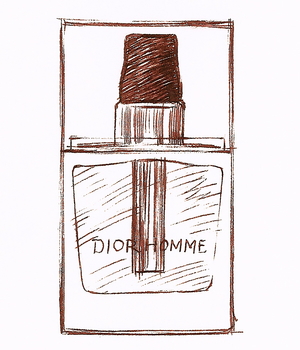Tagged With ‘Dihydromyrcenol’
Christian Dior
Dior Homme
19 May, 2014
 We all have blind spots, and Dior Homme has definitely been one of mine. I was, very kindly, given a bottle some time ago, and I admired its clear glass-and-lucite design, but as for the perfume inside – I just didn’t get it. It had excellent reviews, and it obviously sells well, so I thought I’d better give it another try.
We all have blind spots, and Dior Homme has definitely been one of mine. I was, very kindly, given a bottle some time ago, and I admired its clear glass-and-lucite design, but as for the perfume inside – I just didn’t get it. It had excellent reviews, and it obviously sells well, so I thought I’d better give it another try.
Still no luck, I’m afraid. It’s not horrible (which is a rarer attribute than you might expect), but neither does it make me go ‘WOW!’, which is the response I’m always hoping for. There’s a hint of something in it that I really don’t like, which it shares with a lot of other men’s fragrances today – a slightly metallic, chemical smell, which might come from dihydromyrcenol or perhaps from ISO E Super, both (ab)used with gay abandon by contemporary perfumers.
So why the brilliant reviews? Am I just completely missing something? Actually, I suspect not. Although it was only launched in 2005, it seems that the original scent might well have been tinkered with and reformulated (quite possibly more than once), meaning that the bottle I have probably smells very little like the much-admired original. Which is a shame, as it did sound very appealing, not least because it was created by the talented Olivier Polge, son of Chanel’s legendary in-house perfumer Jacques Polge.
Whatever the truth of the matter, the version I have and the original do seem to share at least one interesting quality. I’ve pointed out before that in itself perfume is genderless – how can a liquid be ‘masculine’ or ‘feminine’? But there are definitely some ingredients and effects that, at least historically, have been more closely associated with women or men. Vetiver, for example, is considered a classic ‘male’ smell, while iris is widely regarded as and ‘feminine’ and ‘floral’ (even though the scent is extracted not from iris flowers but from its roots).
As its name far from subtly suggests, Dior Homme is aimed squarely at men, yet its main smell, even in my rather synthetic-smelling version, derives from iris; compare it with Chanel’s superlative 1932 and you’ll see what I mean. Either this shows that contemporary men are more sophisticated than some might say, or they’re dumb enough to believe anything they’re sold. I like to think the former, but maybe I’m deluding myself; what do you think?
The missing ingredient
29 April, 2014
I’ve been meaning to write a post for some time about an ingredient I thought I’d discovered in the majority of the men’s perfumes that have been launched in the last five years or so, which gives them all an intensely acrid, peppery, chemical smell, like a fire in an electricity substation.
For lack of any better information from the perfume companies themselves I was going to call it ‘cheapone’, since it makes anything it’s in smell so cheap and nasty, but now the estimable Lee Kynaston, men’s grooming guru and blogger extraordinaire, has identified it in a feature he recently wrote for the Telegraph.
Dihydromyrcenol is apparently the culprit, and I’m delighted to discover that Lee hates it as much as I do. The reason for its ubiquity, he explains, ‘is that creative briefs for men’s fragrances often require that they “last all day” because men, unlike women, tend to apply once and don’t bother to top up later in the day. The easiest way to deliver that longevity is to throw some dihydromyrcenol into the mix.’
In a way it’s nice to have one’s suspicions backed up at last by scientific evidence, but what would be even nicer would be if our perfume masters stopped using the revolting stuff and found a more attractive ingredient instead. Or even started using their imaginations again, like perfumers did in the days before dihydromyrcenol.